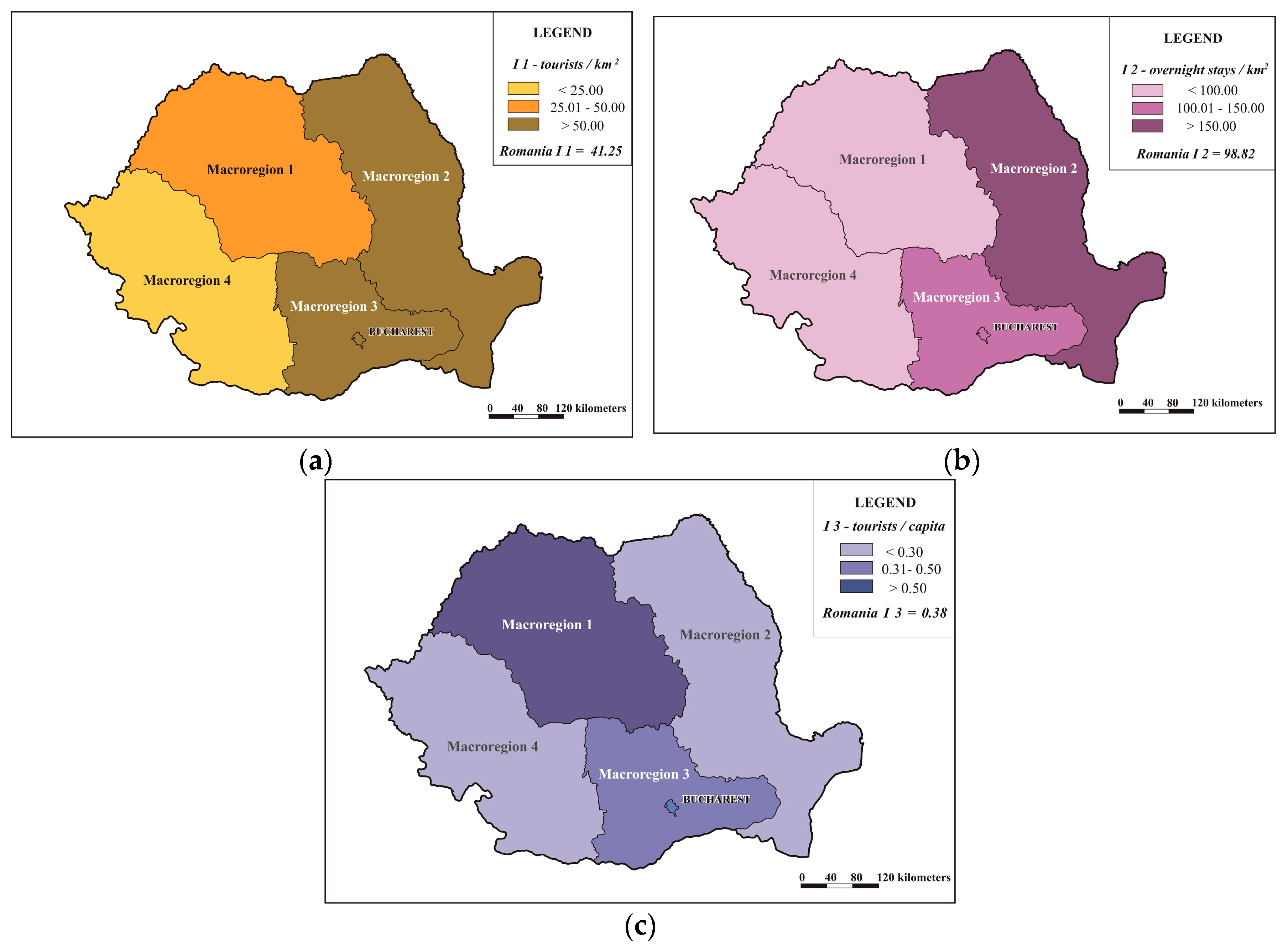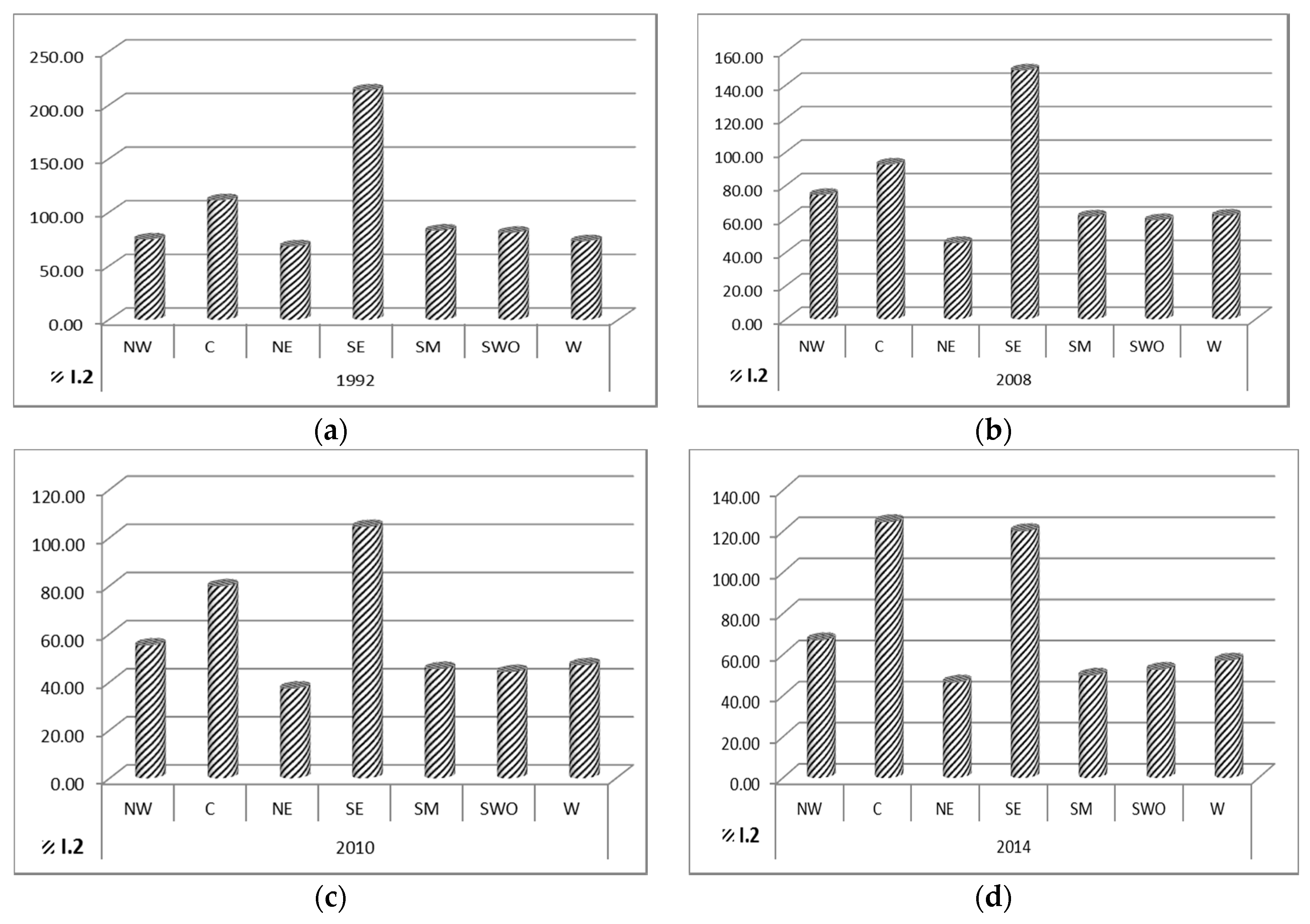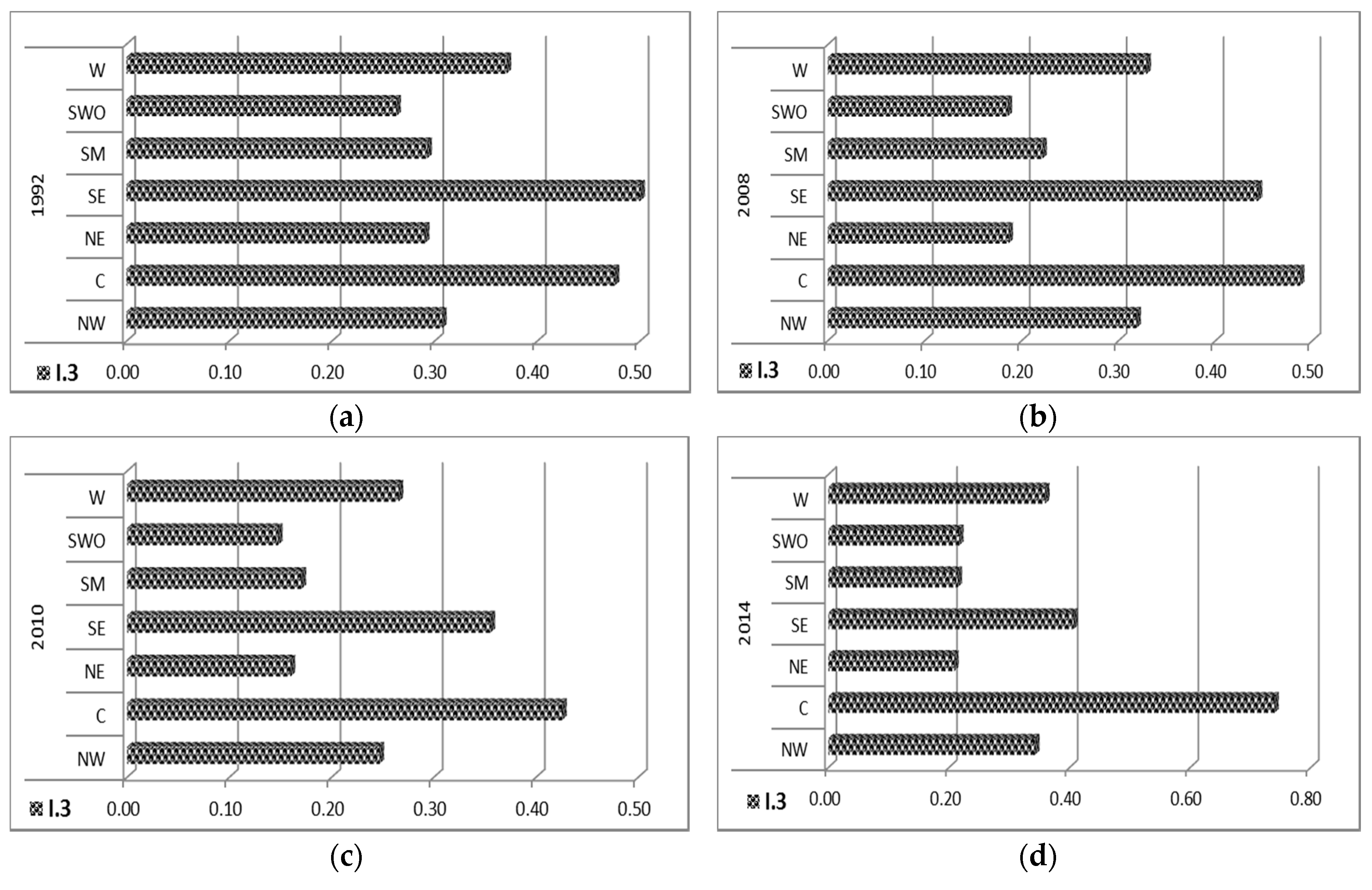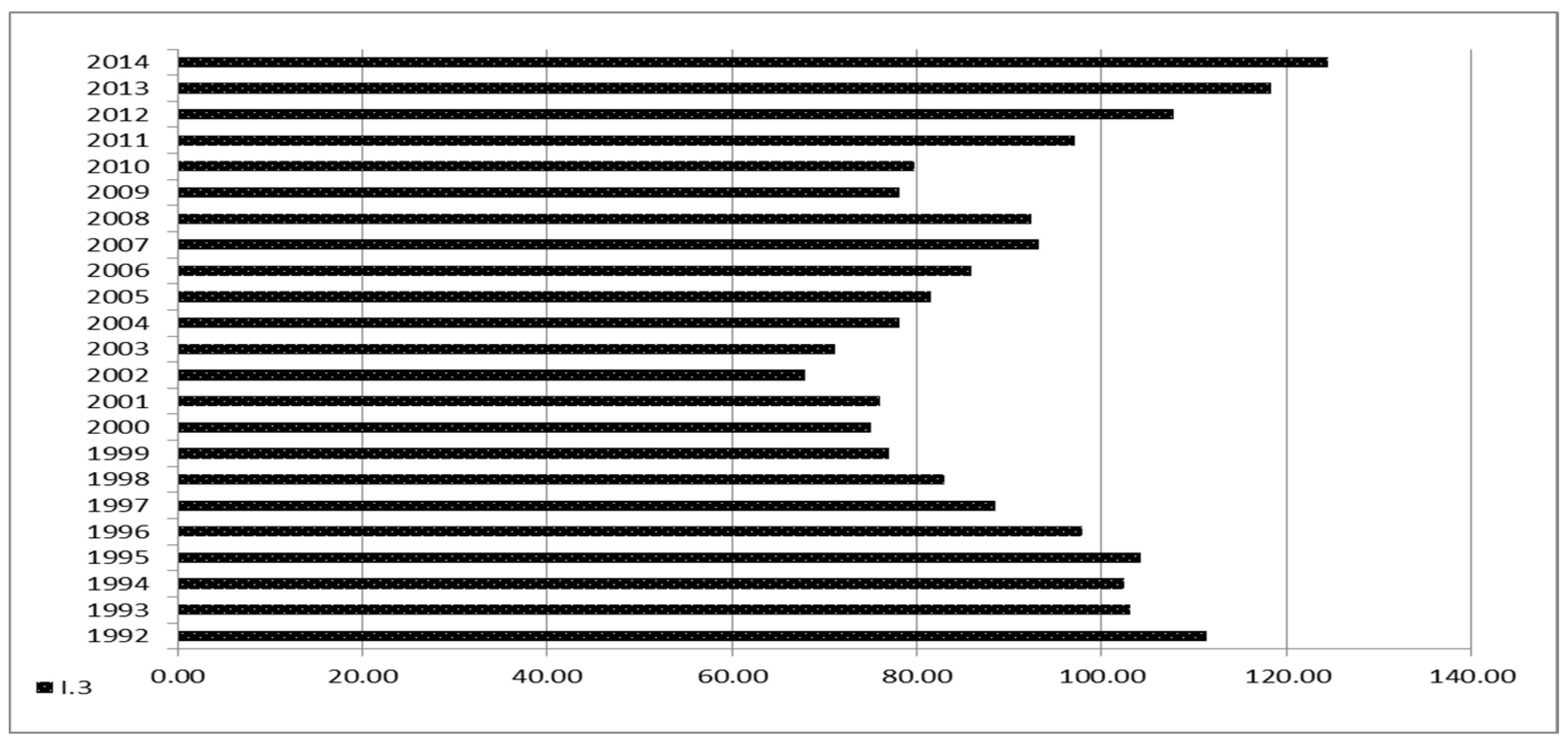The study of the tourism pressure impact in Romania was carried out both territorially and socially for the period 1992–2014. The trend analysis of the three assessment indicators (density, duration and pressure level) at a regional level (by macro-regions and regions) was also more relevant because the more accurate the regions of more intense pressure, the easier mitigating action, in order to maintain the sustainability conditions in order to carry out tourism activities.
4.2. Tourism Pressure Assessment Indicator Trends at Regional Level in Romania
The determination of tourism pressure difference by region in Romania began with an analysis of the indicator trend assessment at the level of macro-regions.
By analyzing the trends of the three indicators highlighting tourism pressure in the four macro-regions, considering the minimum and maximum values (
Table 2), we may state that: regarding the pressure density indicator (I
1), the MR. 4 macro-region, where the fewest arrivals (13.77 arrivals/km
2, in 2002) were recorded, and MR. 2, with the highest density of 66.68 arrivals/km
2, in 1992, stood out; at the level of the same macro-regions, the lowest and the highest values of the density and the duration of tourism pressure (I
2) were shown: MR. 4 with the fewest overnight stays (45.64 overnight stays/km
2, in 2010) and MR. 2 with 257.61 overnight stays/km
2, in 1992; the lowest pressure at social level was recorded in 2002, in the MR.4 macro-region (0.19 arrivals/capita), and the highest in 2014, in MR. 1.
Macro-region 1 (MR. 1), with the NW and Central regions, represents the only macro-region of the four in Romania which recorded positive mean values in terms of the trends of all the three indicators during the period analyzed (
Table 3). The explanation was the particularly complex and varied tourism potential, good tourist infrastructure both in terms of quantity and quality, and also an overall economic growth above the average of the other macro-regions. It is the macro-region joining the highest number of counties (NUTS level 3) with tourism pressure values exceeding the average.
Macro-region 2 (MR. 2), with the NE and SE regions, recorded negative values for all three indicators analyzed. The vast majority of counties fell within the category of low pressure ones, after the interpolation of the three indicators. The main reason was related to the lower tourism potential of these administrative units, which caused a more modest capitalization.
Macro-region 3 (MR. 3) is analyzed by centralizing the data on the South-Muntenia and Bucharest-Ilfov regions. The results showed annual negative mean values of the trend only for indicator I2. Although it is an area with great tourism potential, the tourist flow was characterized by a low duration of stay. A significant distortion occurred here due to Bucharest, which attracted a large number of tourists, but, according to the specific types of tourism, it was associated with a very low duration of the stay.
Macro-region 4 (MR. 4), with the SW and W regions, like MR. 2, recorded negative trend values of the mean indicators, for all the indicators assessing tourism pressure. The tourist potential available for this macro-region required the capitalization of tourism types mainly defined by the short duration of the stay.
The conclusion drawn for all the macro-regions was that the trends of the indicators assessing tourism pressure in the period 1992–2014 were affected by the impact of the economic crisis of 2008. The recovery has been highlighted in most cases since 2011. This process unfolded differently in the sense that the only macro-region exceeding the level before the crisis (even over 1992) was macro-region 1, defined by very good economic growth (comparable only to the Bucharest-Ilfov region) and by a quantitative and qualitative diversification of tourism-specific infrastructure (too much even in the case of accommodation structures)—
Figure 3a–c.
The analysis of the regional tourism pressure trend would be much clearer if we continued the research on the action change of the three indicators in the eight development regions of Romania that make up the macro-regions.
Compared to the other seven development regions of Romania, the values of the indicators assessing tourism pressure territorially and socially for the Bucharest-Ilfov region required a separate analysis.
The Bucharest-Ilfov region faced a “suffocation” process in terms of the territorial tourism pressure. This phenomenon was the result of the number of arrivals and overnight stays, which was so high, relative to the small size of the region, that it generated a density and an intensity over 10 times higher than the tourism pressure duration. The explanation was that the region comprises mainly the capital, and most tourists practiced business tourism.
In this context, the region underwent a trend of average growth in terms of all three indicators determined during the analyzed period from 1992 to 2014.
The indicator I1 had an overall average increase with about 23 arrivals/km2 annually, with 3.86% per year, respectively. Thus, from 389.05 arrivals/km2 in 1992, the tourist density was to be much-reduced by 2001, when it would reach a minimum of 267.94 arrivals/km2. In terms of tourism pressure, the decrease process was favorable, although it was set on the reduction of the tourists’ numbers, with a negative impact on the tourism activity and, therefore, the economic activity of the region. Since 2002, the indicator of tourist density has increased every year, even after the crisis of 2008 (with a small exception in 2004 when it decreased insignificantly), reaching a maximum value of 895.26 arrivals/km2 in 2014.
The same trend pattern was shown by the second indicator assessing the intensity of tourism pressure duration, only this increase was of 1.35% per year, actually about 17 overnight stays/km2 annually. However, from 1088.41 overnight stays/km2 in 1992, it decreased to 531.32 overnight stays/km2 in 2001, while the subsequent increase would lead, over time, to the maximum recorded for the indicator of 1461.23 overnight stays/km2 (2014).
The trend values of the two indicators clearly highlight not only their classification into the last category (VI), but also a surplus beyond what fits within the set categories. This reveals the acute issues of the region in terms of sustainable development.
Considering the fact that this region includes Romania’s capital, with the largest number of people, we may explain why the values of the last indicator fell within the categories mentioned and do not create problems for the sustainability process seen through its social dimensions. The average increase with 3.8% annually, interpreted effectively as 0.017 arrivals/capita per year, was determined based on a trend ranging from a minimum of 0.20 arrivals/capita (2001) to a maximum of 0.65 arrivals/capita, in 2014.
Regarding the other seven regions, the analysis of the tourism pressure trend included the emphasis of the three indicator dynamics for each region and the study of the significant differences per indicator existing between the regions included in the study.
For a much clearer emphasis of the trend stages of the indicator of tourism pressure density (I
1), we built comparative figures (
Figure 4a–d) representing its values for years prior to the global financial crisis (1992 and 2008), as well as for years after the crisis (2010 and 2014). The indicator values showed that the greatest change over time in reducing tourism pressure density was recorded in the NE region until 2010. One explanation is that there is quite a high number of local interest resorts experiencing big setbacks, some of them being practically decommissioned.
The overall dynamic of tourist density per region in the period 1992–2014 was: regions experienced a progressive decrease in the density of tourism pressure; decreases ranging on average from a minimum of −0.448 arrivals/km2 annually (the South-Muntenia region) and −0.079 arrivals/km2 annually (the Western Region), meaning average rates of −1.77% per year for the first region and −0.33% for the second one. Other regions that experienced this process of decrease were: SE, NE and SW-Oltenia; only two regions recorded average increases: the NW region with 0.083 arrivals/km2 annually (0.30%) and the central region with 0.888 arrivals/km2 per year (1.91%).
Another approach to the trend stages of the indicator I1 was the analysis of the differences between the tourism pressures on the number of arrivals/km2, whether significant or not, among the eight development regions of Romania.
The hypothesis H1 (the ANOVA Single Factor) was supported by the results of the variance analysis. Thus, the significant difference between the tourism pressures in the regions was highlighted by the Fisher test, whose value of 10.15 was significantly higher than its critical value of 2.16. Also, this aspect was rendered through the value p-value = 1.9 × 10−9, determined as being significantly lower than the significance threshold of 0.05 corresponding to the result guarantee probability of 95%.
The major differences were given, to a greater extent, by the infrastructure and accessibility compared to the tourist potential.
The tourism pressure duration determined for the number of overnight stays/km2 (I2) aimed to complete the tourism pressure picture because the introduction of the overnight stays in the quantification of this process reduced the influence of one-day visitors. The pressure exercised by tourists spending the night in the studied area was higher.
The distribution of this indicator in the development regions,
Figure 5b, showed a different situation from the previous ones, the explanation being related to the influence of health tourism (a type of tourism that involves a greater duration of stay) and seaside tourism. The highest values occurred in the South-East and Central regions, where most spa and seaside resorts are located.
The values of the indicator for 1992, 2008, 2010 and 2014 are shown in
Figure 5a–d. The South-East region clearly stood out, followed by the Central region, represented in all years of the period, the reason being connected, as previously stated, to the presence of the seaside (which implies a greater duration of stay) and the spa resorts.
In the first case, the explanation was connected to the high density of spa resorts, and, in the second case, to a small area. We should also state that the maximum values in both cases were recorded in 2014.
The situation of these regions is not very favorable, considering the values of more than 100 overnight stays/km2, which classified them within category VI and described the increased tourism pressure in terms of the pressure duration faced by them, which would have serious repercussions on the sustainable development process.
In the case of the other regions, the maximum values were recorded either at the beginning or at the end of analyzed period.
The analysis of these indicator dynamics during 1992–2014 revealed an average increase of tourist density only in the Central region, by 0.596 overnight stays/year (0.51%).
The most significant decrease of the indicator I2 was determined for the South-East region (by 4.254 overnight stays/km2, representing a decrease of 2.59% annually). The regress was triggered by the significant flow of Romanian tourists for the summer holidays to other countries (Bulgaria, Greece, Turkey, etc.), while the number of foreign tourists in Romania dropped sharply as a consequence of the low quality of the services offered.
The assessment of the differences between the seven development regions of Romania (significant or not), in terms of tourism pressure duration (overnight stays/km2), was also achieved by applying the ANOVA Single Factor function.
The results of the ANOVA Single Factor function application on the data series of I2 in the seven development regions in Romania, in the period 1992–2014, supported the regional manifestation of the significant differences between their tourism pressure duration. The viability of the alternative hypothesis H1 is evidenced by the Fisher test, and its value of 135.62 is significantly higher than the critical value of 2.16. The value p-value = 7.54 × 10−59 was determined as being significantly lower than the significance threshold of 0.05, corresponding to a result guarantee probability of 95%.
Although the differences are significant, the issues raised are felt only for regions with spa and seaside resorts, which have a proper specific organization that does not affect sustainable development too much.
The regional analysis of the third indicator trend (social impact of tourism)—I3, determined by the number of tourist arrivals/capital ratio, also began with an analysis of its dynamics during the period specified.
The values of the indicator for 1992, 2008, 2010 and 2014 are shown in
Figure 6a–d. The first three places were shared between the SE, Central and West regions. We noticed the effects of the economic crisis for the years 2008 and 2010 in the case of this indicator, as well. The highest values were recorded in the South-East (1992) and Central regions (2010 and 2014). Like in the previous case, the Central region showed the most significant increase after 2010.
Regarding the region development (NUTS level 2),
Figure 6b, we identified the Central region to have values of between 0.43 arrivals/capita and 0.74 arrivals/capita, which classified it in categories V and VI, thus with a high level of tourism pressure at a social level, which can create problems for the future sustainable development process of the region. Values above the national average (0.32 arrivals/capita) also occurred in the West region.
At the other end of the scale, there was the South-West Oltenia region with indicator values ranging between 0.15 arrivals/capita (2010) and 0.26 arrivals/capita (1992).
The first three categories,
Figure 6c, below the national average, totalled 64%.
Further analyzing the dynamics of this indicator during the period 1992–2014 and pursuing the same issues, it may be noted that the same regions, Central and North-West, showed overall increases (by 0.012 arrivals/capita, and 0.002 arrivals/capita, or 2.03% and 0.50% per year, respectively), as with the first indicator.
The other regions showed average decreases of the indicator I3 between 0.005 arrivals/capita per year (South-East), and 0.0005 arrivals/capita per year (West Region).
Following the ANOVA Single Factor function application on the data series of I3 during 1992–2014, the results obtained for the seven development regions of Romania led to the conclusion that there were significant differences between the development regions of Romania in terms of tourism pressure, given by the number of arrivals/population.
The alternative hypothesis H1 was supported by the dispersion analysis results shown by the Fisher test, whose value of 72.78 was significantly higher than its critical value of 2.16. The result was confirmed by the value p-value = 1.89 × 10−42 determined as being significantly lower than the significance threshold of 0.05, corresponding to the result guarantee probability of 95%.
In areas with high values, there were issues with sustainable development, the residents’ perception not being a favorable one.
The results led to the conclusion that there were significant differences between the eight development regions of Romania, both in terms of tourism pressure, given the number of arrivals/country surface, the number of arrivals/population and the duration of tourism pressure (number overnights/km2).
The policies and strategies approached at the national level regarding regional development aimed at the settling and the reduction of disparities between regions. However, in terms of tourism pressure, the decrease process was not very widely visible.
To highlight the tourism pressure on the fundamental directions (economic growth, environmental sustainability and social equity), the existence of long-term relationships was tested. The variables were considered significant and included in the analysis, representing both tourism pressure (through the three comparison indicators: I1, I2, I3) and the regional development process (GDP and VH).
The econometric model was based on the cointegration analysis including the aforementioned indicators, during 2000–2014, and within the eight development regions of Romania. The first stage of the cointegration test aimed at testing the integration order of each variable, considering that all the series should be integrated by the same order. The analysis was initially aimed at the level series study, the results being shown in
Table 4.
The critical probability values (Prob. **) corresponding to the
Augmented Dickey Fuller Test (ADF) test for each variable (I
1, I
2, I
3, GDP, VH) were greater than 0.05 (
Table 4). These results led to the conclusion that the risk was greater than the standard threshold of 5%, thus the unit root hypothesis for level series of each variable was accepted. These results led to further testing the series by testing if there was a unit root within the differentiated variable series.
The analysis of the series result differences on all five variables (
Table 5), through the critical probability values (Prob. **) of the ADF test, which was lower than 0.05 (the standard threshold of 5%), produced the risk that the unit root of the series D(I
1), D(I
2), D(I
3), D(GDP), D(VH) could be lower than 5%. Consequently, the analyzed series on the development regions of Romania was considered to be integrated by the order I.
The conclusion of the first stage allowed the application of the Johansen Cointegration Test. This test was applied while the GDP and VH were endogenous variables.
Of the three cointegration models (
Table 6) the first one was selected (associated with the lowest critical probability value Prob. ** = 0.00 < 0.05, meaning that the risk was the lowest compared to the standard threshold of 5%), which included all three exogenous variables.
The Johansen test indicated a cointegration relationship between the variables analyzed (
Table 7), within a trendless model, without entailing an equation emphasizing the long-term stable relationship between the GDP endogenous variable and the tourism pressure variables (I
1, I
2, I
3).
The cointegration model equation coefficients (1) indicated very clearly, through their positive signs (they always occurred with the opposite sign to that shown in the table), the stable long-term relationship, in view of a GDP growth under tourism pressure increase.
Of the two cointegration models tested (
Table 8) and analyzed, the first one was selected (associated with the smallest value of the critical probability Prob. ** = 0.00 < 0.05, meaning that the risk was the lowest compared to the standard threshold of 5%), which included the two exogenous variables (I
1, I
2).
The same Johansen test indicated, in this case as well, the existence of a cointegration relationship between the variables analyzed (
Table 9) in a trendless model. An equation was thus obtained, highlighting the stable long-term relationship between the VH endogenous variable and the tourism pressure variables (I
1, I
2, I
3).
The positive signs of the cointegration model equation coefficients (2) showed the existence of a long-term stable relationship, meaning an increase of VH under tourism pressure increase.
The conclusion was that an increase in tourism pressure indicators (I1, I2, I3) entailed the modification in the same path of GDP and VH, while leading over time to results with significant impact on the regional economic growth. Tourism pressure may be a very important component of the regional development of Romania over time, but great attention should be paid to the policies and strategies adopted, because a component with a positive impact could become one with a negative impact if actions are not carried out to ensure the sustainable development of tourism while it intensifies.
The econometric model based on the cointegration analysis highlighted the long-term existence of a steady relationship as a trend analogy during 2000–2014, taking into account the distribution in all the eight development regions of all indicators at the level of Romania.
It was a manifestation of regional policy, which paid special attention to the planning and management of location conditions, distributing the tourist activities. In these circumstances, it is necessary to focus on how development should take into account the sustainability process.
The conclusion was that the implementation of Regional Development Policy of Romania was extended and included all the fields of activity, implicitly including tourism, but the results of the analysis showed that the impact of territorial imbalances was quite significant on regional development and over time should be subjected to the sustainability process, which should be more visible in Romania.
In this context, the drafting of strategic measures required the application of selection criteria of economic, environmental and regionally sustainable policies to allow a permanent structural adaptation and a significant contribution of tourism to the sustainable regional development.















